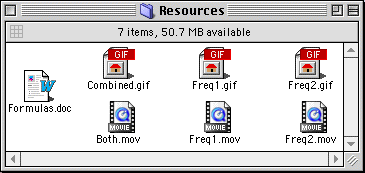 |
|
Discussion: We have already talked about constructive and destructive interference, so you should already have a feel for how this works. Look and listen to the two sounds below. Can you hear a difference? Don't worry if you can't; we can't all be musicians! Let's say you were trying to tune a piano however. You need to know whether or not the frequencies match...
Listen carefully to the combined sound. What do you hear? You should sense a series of beats, 3 per second to be exact. This is called the beat frequency, which is caused by the interference of the two sounds. You should count 3 "beats" per second. There is a simple way to predict the beat frequency if you know the two source frequencies. This may seem simple, but just subtract the two source frequencies, and that will be the beat frequency. Since negative values do not make sense, they are adjusted to positive values. If we know two of the terms can we get the third? Sometimes.
We know that the ??? value could either be 303Hz or 297Hz. How does the piano tuner adjust the string. If he tunes it in the wrong direction by either tightening or loosening the string, he would hear even more beats per second, so he knows he should go the other way. For the curious, the two actual frequencies were 300Hz and 297Hz.
|




